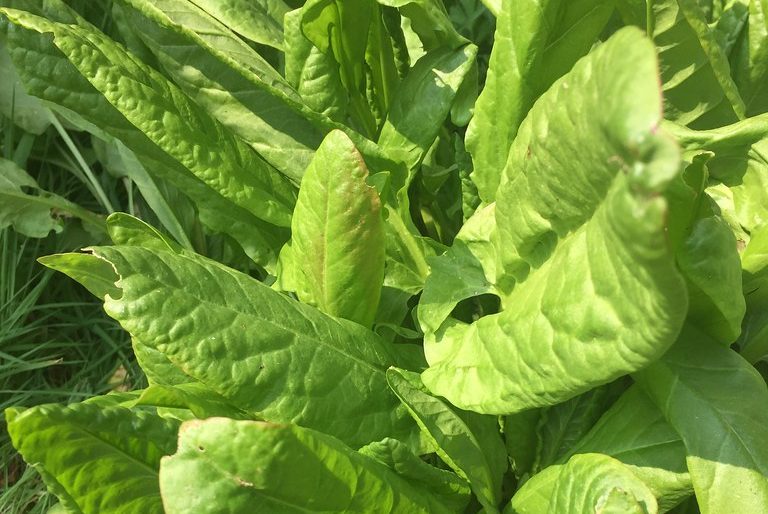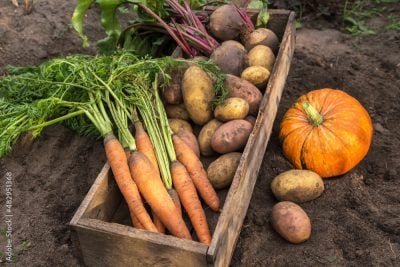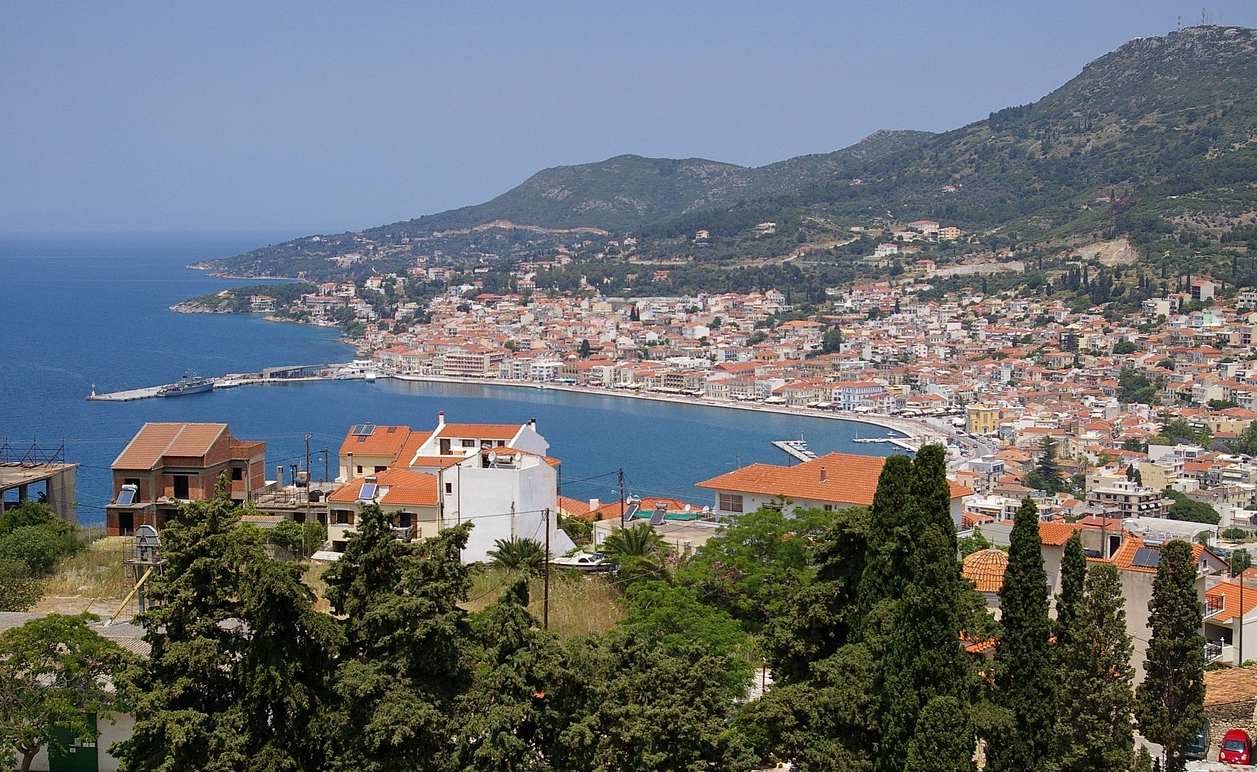Perennial Vegetables: A Must Have
by D.P., Survival Blog:

In this article, I’ll explain why I consider perennial vegetables a “must have” for my self-sufficiency garden.
It was during the time I lived in Kamakura, Japan, a once short-lived capital of Japan about an hour southwest of Tokyo, the place where both of my sons were born, that I learned to garden. Fell in love with it really. At that time my wife and I lived in a small duplex. All rooms were floored in tatami mats (straw mats). You couldn’t wear shoes on them, one of the few customs which the Japanese wouldn’t allow under any circumstances. The smell of straw filled the air and it just felt right walking barefoot on the dried grass mats.
Behind our apartment was an empty lot owned by our landlady, Suzuki-san. It was empty except for bamboo and weeds of all kinds. We were very close with our landlady and it turned out over time that she would let me use the entire lot, about half a soccer field, as a garden on the condition that she could get some of the veggies. It turned out great and there were many weekends we were all out there picking weeds or picking vegetables together.
At the time I grew different vegetables with varying amounts of success. Corn, tomatoes, cherry tomatoes, potatoes, onions, garlic, green beans, arugula, lettuce, spinach, peanuts, taro, soybeans, peppers, carrots. All of it was grown organically without fertilizer. I’d compost what I could, used cow manure (not sure if could be considered organic or not) and used Neem oil as a pesticide with moderate success (and lots of picking off insects by hand).
Some of my happiest memories of that time were going out to the garden with my then 2 year old son and eating cherry tomatoes off the vine; digging under the peanut plants thinking they were dead just to find a buried treasure trove of peanuts to my surprise; digging up large numbers of huge potatoes and making my own French fries; and laughing my butt off at how pitiful my tiny, twisted corn cobs looked.
THEN I LEARNED ABOUT BAMBOO SHOOTS
It was at that time that Suzuki-san introduced me and my wife to something about our plot that started me on what to me has been an exciting journey to this day. It started off as something unsurprising. In the spring she brought us some bamboo shoots from bamboo that grew on one side of the plot, growing over into the neighbors’ yard. I thought it was neat that she was foraging for wild edibles. But it was more than just that. We all can and should learn about the wild edibles that can be found around us. That knowledge is necessary to our survival if anything catastrophic should happen that disrupts our ability to buy food. But she pointed out that there were actually many more vegetables we could find in our plot that just kept growing and coming back year after year: Perennial vegetables.
Suzuki-san showed us Nira growing all over the place. Nira is known as Chinese Chives, in English. Then there were tons of aggressive Fuki. It starts popping up in early spring and have deep green round leaves with longish stalks under them. It’s the stalks you eat. You cut off the stalk, careful not to pull it out of the ground (unless trying to get rid of some of them from growing back next year), boil them, and peel off the outer skin. Very nutritious. Just need to boil with a little sugar and perhaps soy sauce or salt. There was also Shiso, also known as Japanese basil. Not actually a perennial but seeds so wildly that will absolutely pop up year after year like a perennial. My wife loves Shiso as do most Japanese. I personally don’t like it the way they usually eat it, raw with sashimi. But sautéed as a pasta sauce with olive oil is amazing. Tastes a bit like pesto. And Myoga, also known as Myoga ginger or Japanese ginger grew in our plot. A delicacy in Japan. Not spicy at all. Usually used as a garnish. Where I live now I grow Shiso and Myoga. I could make a great profit from them where I live, but between my wife and the Japanese community around here, it’s gone pretty much as soon as it’s picked.
A FEW PERENNIALS TO CONSIDER
Besides giving me a great deal of satisfaction in cultivating things off my plot that I hadn’t planted, it got me thinking deeply on what other perennial vegetables were out there. And I don’t mean the foods we usually think of as perennial, like fruits and nuts. I mean vegetables. And there are a lot!
Let’s skip over the ones we are all familiar with such as asparagus, rhubarb, and perhaps globe artichokes and let’s see what’s out there. There are too many to discuss in this article, so I’ll just point out the ones I recommend and have grown, and things we should keep in mind about perennial vegetables. They make the perfect complement to the annuals you grown in your garden. Let’s take a closer look at them.
Sunchokes
Also known as Jerusalem artichokes. Besides asparagus, this is one of my favorite perennial vegetables. They are native to the US and can be grown pretty much anywhere in the States, even where there is frost. They are related to the sunflower and their flowers look a bit like small ones. You eat the tubers and they will produce huge amounts of them. These tubers are really tasty and sweet and can be eaten raw. You can use them just like potatoes. Baked, mashed, in soups, or raw. The main drawback to sunchokes, and for many perennial vegetables (besides a little gas..), is that they will spread wildly. Either plant them where they’ll have plenty of room to spread or give them their own large bed. Just make sure to harvest and thin to keep them in check.
Good King Henry
Another great perennial vegetable. You can eat any part of it, but it’s mainly been grown for it’s shoots (just like asparagus or cattails). Very tasty cooked just like asparagus, with olive oil or butter and salt and pepper. But you can eat the leaves, flowers, seeds, and all as well. It will produce tasty shoots before your asparagus pop out and weeks after asparagus stops popping out shoots to eat. I consider it a must have perennial vegetable. It will grow in full sun or partial shade.
Sorrel
The sorrel plant (pictured at the top of this article) looks a little bit like spinach and is one of the most dependable perennial vegetables out there. They’ve been grown for a long time in Europe. Use them pretty much the same way you would use spinach. Eat them fresh or in salads or in soups. I like them cooked but can’t say I love the leaves eaten right off the plant. Just a little bit too lemon-ish for me. But they are great cooked and can be eaten from the spring to the autumn.
Potato Onions
This is a great perennial and will give you tasty onions reliably year after year. They are a bit smaller than the usual large onions we tend to grow, but not so much so. And they are used exactly like you would any other onion, the bulb or greens. Their taste is excellent. It is a perennial, but what you really need to do is pull out the bulbs but leave a few in the ground to grow new onions the next year or save some bulbs to replant next year. You might also want to move their location around a bit. Replant or leave in the ground the smaller bulbs. For some weird reason the smaller bulbs tend to produce the larger onions next season. Store them the same as regular onions.
Daylily
Yes, the very common yellow or orange lily we see growing all over the place, like on the sides of the road. These are very much edible and should be grown by everyone interested in gardening for self-sufficiency. They’ve been grown and eaten in Asia for a long time. You can eat the young leaves and the small tubers, but it’s mainly the flowers and flower buds that are eaten. Eat them as-is in salads or sauteed or deep fried (the author pretty much likes anything deep fried…).
PERENNIALS I’VE BEEN WANTING TO TRY:
Yams
Despite what you might think, Yams are perennial vegetables that can be grown almost anywhere in the United States, and not just some tropical type sweet potato. The kind that we can grow throughout the US and not just the milder or warmer / temperate areas is a very common and popular root vegetable in Japan called nagaimo, but in English called Chinese Mountain Yam. From what I understand just leave some of the tuber in the ground for it to produce more. My wife and I eat this regularly and get it from a local Asian supermarket. You can eat it raw. It has a crisp, crunchy texture. It’s a bit like okra in that it a little sticky, I guess is the word to call it. Sauteed is nice, too.
Air Potatoes
I’ve been wanting to try air potatoes for a while now but just need to find an area on my property to dedicate to it. I’m definitely in the proper climate, needs more of a warmer climate, like the southeast where I am (all the other veggies above can be grown pretty much anywhere in the US). But it can become invasive, so a space must be carefully plotted for it with metal or plastic edging buried fairly deeply, similarly to what you would use for most spreading bamboos). The allure of air potatoes is pretty much how they sound- potatoes growing from vines in the air, like say from a trellis. The yields are supposed to be huge and of course they are perennial so no need for sowing, digging, plowing. They are usually about the size of an apple and are cooked like any other tubers, like potatoes.
Fiddlehead Ferns
Although not eaten widely in the United States, they should be since they are both delicious and can grow almost anywhere in the United States perhaps except for the warmest areas of the southern states. They are grown and cooked widely in Japan and you can find them in all the supermarkets there in the spring. We’ve all seen them growing in the forests for sure. These are the sprouts/shoots of the Ostrich Fern, large common fern found throughout the northeast but can be found in most places in the US. Harvest the shoots in the early spring. Just don’t pick them all as you’ll want some to come back the next year. Pick them when they are still curled up and look a bit like, well, fiddleheads. Steam or boil for about 10 minutes. I don’t have enough forested land for a large colony, but if I did I would get large colonies started in the areas between my fields and the woods proper.
Ramps
This one is truly a native American perennial vegetable, living wild in the good old USA. Just look online and you’ll see tons of information about them. They even have Ramp festivals with foods celebrating their flavor. They are wild leeks and very tasty. I’ve always wanted to start my own colonies but haven’t for the same reason as above for the Fiddlehead ferns. They really need to be grown in similar conditions, they love shade and wet forests. They are native to the eastern US, especially in the mountains of the southeast. They grow in small colonies. Dig up a whole plant, bulb and all, but not all of the plants in a colony. You can eat the bulb, like a mild onion or you can also just cut off leaves from some plants.
Loading...



